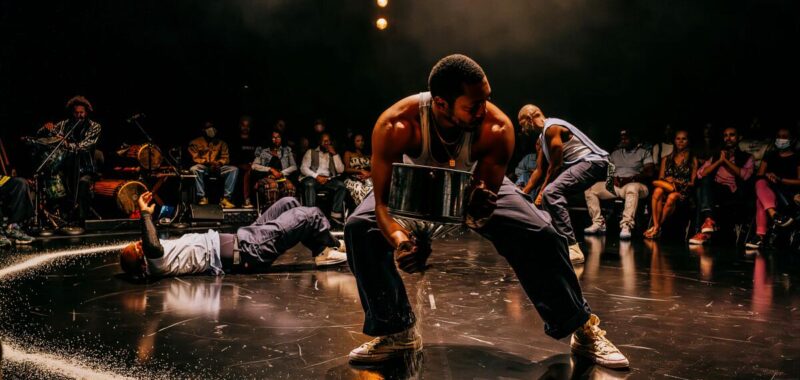Playwright and Oscar-winning screenwriter Tarell Alvin McCraney (“Moonlight”) was appointed artistic director of the Geffen Playhouse last year, but the McCraney era really began on Thursday night with the opening of a muscular revival of “The Brothers Size” at the Geffen Playhouse’s intimate Audrey Skirball Kenis Theater.
The play, part of the acclaimed trilogy “The Brother/Sister Plays,” launched McCraney’s meteoric rise in the American theater. McCraney was still a student at the Yale School of Drama when “The Brothers Size” was first produced. When I saw the play at the Public Theater in 2009 as part of the trilogy, I was keenly aware of being in the presence of a breakthrough talent.
What stood out about all three plays (including “In the Red and Brown Water” and “Marcus; or the Secret of Sweet”) was the freedom of the playwriting voice — the mix of lyricism and raw realism, the musicality blending joy and pain and the playful theatricality that trusted the imaginations of theatergoers and turned stage directions into spoken-word poetry. But none of this would have had the impact were it not for the sensitivity illuminating marginalized lives, a sensitivity capable of deconstructing race, class and gender while honoring the cultural soil from which the characters have emerged.
Drawing on West African spiritual traditions, “The Brothers Size” relates the mythic story of two bayou country Louisiana brothers in conflict that is as tender as it is fierce. But the real subject is the plight of modern Black masculinity, victimized by white supremacy and harassed by a justice system that would rather lock up Black men than provide them with decent opportunities.
Hardworking Ogun Size (Sheaun McKinney) is unyieldingly committed to the straight and narrow path. That is not the preferred road of his younger brother, Oshoosi Size (Alani iLongwe), who has been recently released from prison.
Oshoosi resents Ogun’s martinet ways. He’d rather sleep late than wake up before dawn for a grueling day of fixing cars under his brother’s browbeating supervision. “That’s your job,” Oshoosi tells him. “That car shop got your name, that’s your job.” Ogun, knowing that employment is part of Oshoosi’s parole conditions, pointedly asks where’s his job then.
The names of the characters are taken from Yoruba mythology. Ogun is a warrior associated with metal work; Oshoosi is named after a wandering spirit renowned for hunting as well as contemplation and artistic pleasure.
There’s a third character, Elegba (Malcolm Mays), whose name signifies the trickster. And that is indeed the part he plays in what develops into a contest for Oshoosi’s soul.
Ogun wants to protect his brother from succumbing to the same mistakes. Elegba, jealous of the brothers’ bond, wants to liberate the erotic life of his former fellow inmate and bestows on him a gift that is simultaneously a ticket to independence and a trap.
Oshoosi must choose between different forms of freedom and different kinds of imprisonment. Can he deny his flesh and blood longings and his yearning for relief from an enduring sorrow?
The homoerotic dimension of Oshoosi and Elegba’s relationship is undeniable, but in this co-production with New York’s the Shed, director Bijan Sheibani doesn’t allow the queerness to dominate the play’s larger exploration of Black masculinity. Of the four productions I’ve seen of the play, including the Old Globe’s and the Fountain Theatre’s, this is perhaps the straightest.
Which isn’t to say that it’s repressed. Gay love and lust break through, but the revival is more curious about the range of outlets for tenderness among Black men. “Try a Little Tenderness,” the Otis Redding classic, figures prominently in a play in which acceptable expressions of love between men is punishingly limited, leaving an ache that can grow dangerous when unconsoled.
Ideally suited to the Geffen Playhouse’s second stage,“The Brothers Size” unfurls in darkened concentration. The audience surrounds the playing area as though witnessing a prize fight or highly athletic dance piece.
The black stage is encircled with white powder, creating a special zone of theatrical imagination. Musician, composer and sound designer Stan Mathabane supplies live accompaniment that lends the action a percussive build.
Suzu Sakai’s scenic design, Adam Honoré’s lighting and Juel D. Lane’s choreography work in tandem to intensify the sense of propulsive physical theater. Dede Ayite’s costumes conceal the characters’ individuality unnecessarily, but Sheibani seems opposed to superficial over-illustration and has the actors discover the roles anew through the personal textures they bring.
McKinney’s Ogun is the clearest presence on stage, a reflection not only of his more single-minded character but also of the lucidity of his playing. iLongwe gives vent to the furious restlessness inside Oshoosi without losing sight of the grief that’s animating it.
Mays’ Elegba is too cagey to be pinned down. He lays down temptations and then acts as though Oshoosi is simply following the dictates of his own wild nature. Here, Elegba’s jealousy is as complex as Ogun’s tough love. Oshoosi, drowning in emotional need, is only cast further at sea by the battle to control him.
McCraney, who translates buried anguish into monologues of rough delicacy rarely found outside the plays of August Wilson, finds the mythological patterns in lives that have been underrepresented and uncompassionately seen. For all the high testosterone conflict in “The Brothers Size,” the play makes a social justice case for the healing power of male vulnerability and the saving grace of brotherly (in the widest sense of the word) love.

